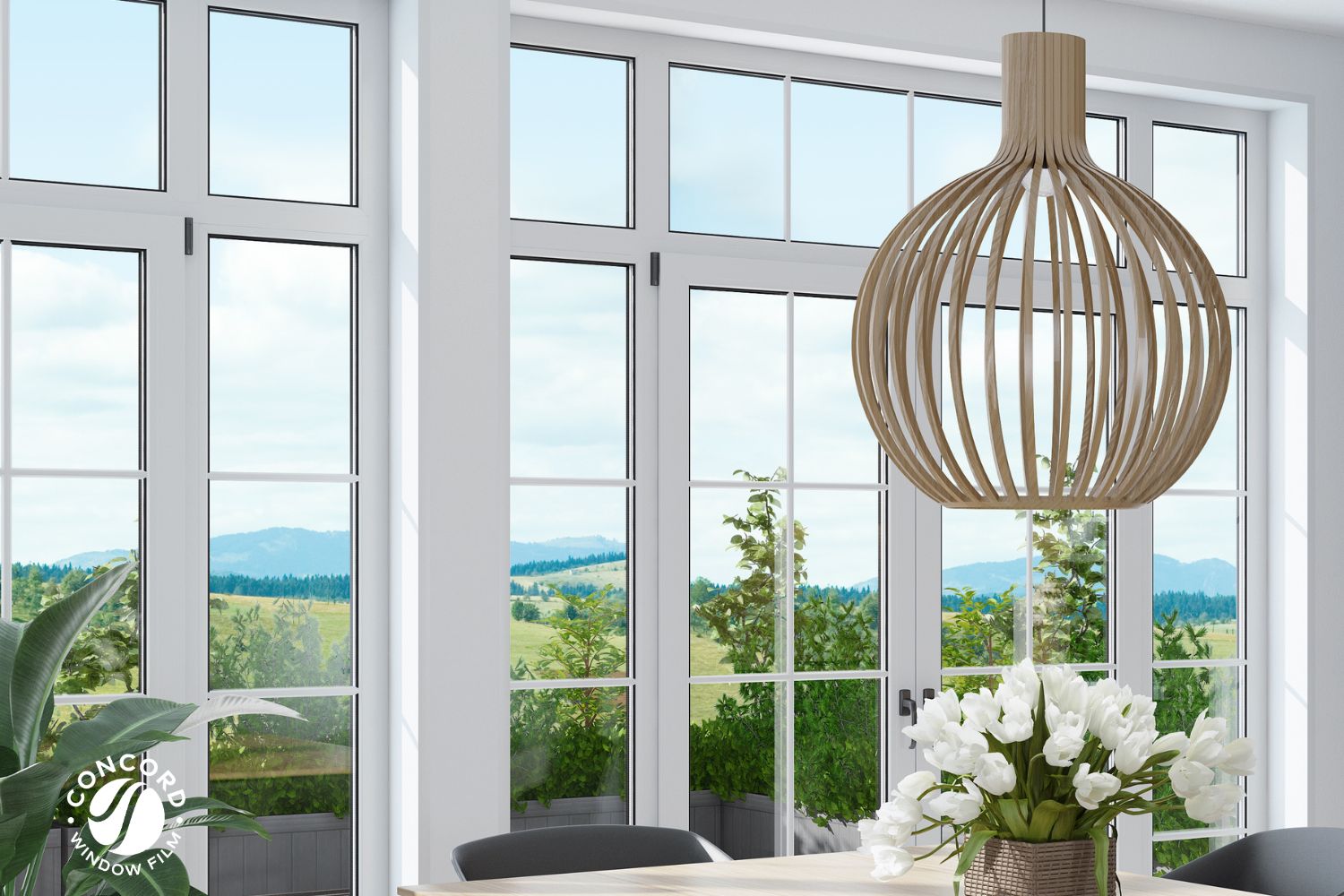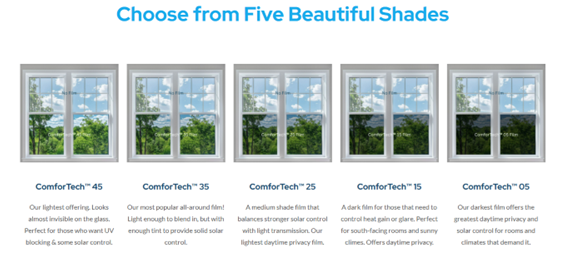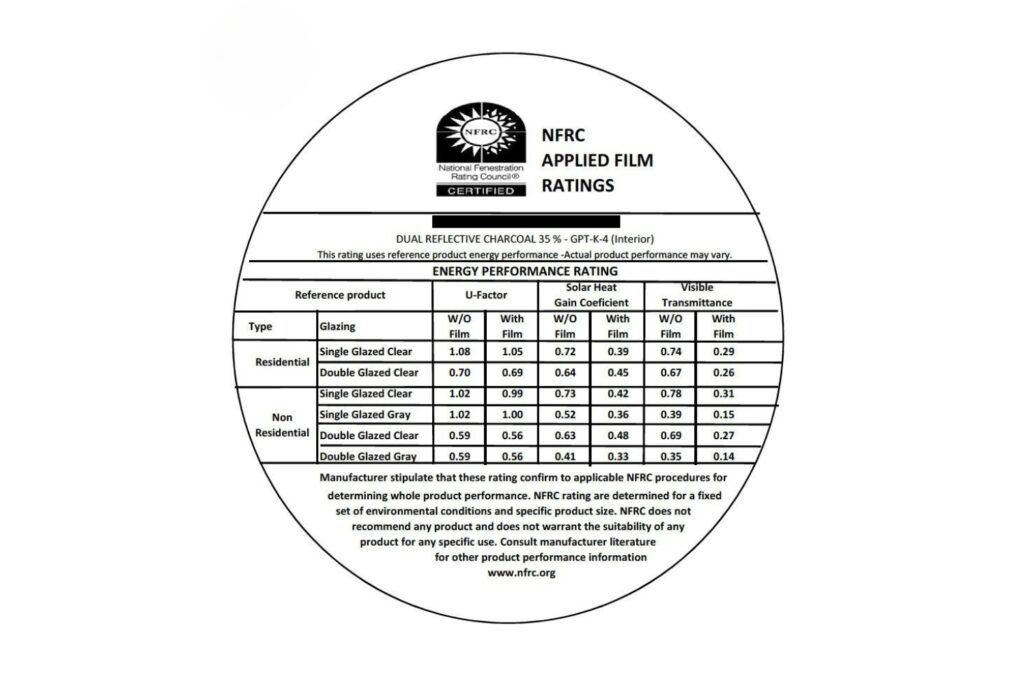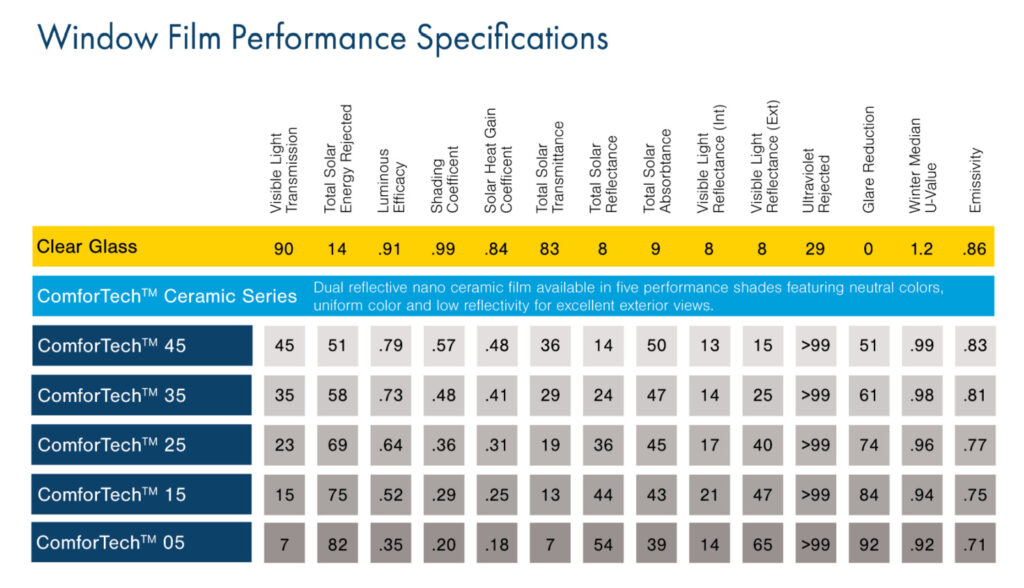
FREE SHIPPING ON PRECUT KIT ORDERS OF $100 OR MORE

When it comes to enhancing the performance, efficiency, and comfort of buildings, window film is an effective and economical solution. When you are looking to reduce energy costs or seeking improved heat control and UV protection, evaluating the right window film is critical.
At Concord Window Film, we believe informed decisions start with understanding performance metrics. So, we are laying out the three most important performance metrics for evaluating the effectiveness of solar control window film.
The National Fenestration Rating Council (NFRC) and the International Window Film Association (IWFA) have defined the main performance specifications that help determine the effectiveness of window films: Visible Light Transmission (VLT), Solar Heat Gain Coefficient (SHGC), and Total Solar Energy Rejected (TSER).
Let’s break down these core specifications and how they contribute to window film performance.
Before diving into the specifications, it’s important to understand the role of the National Fenestration Rating Council (NFRC) and the International Window Film Association (IWFA):
Both entities promote energy efficiency and help consumers make better decisions when selecting window films by offering a consistent rating system.
It’s useful to review how window film works to control the sun’s energy to fully understand the performance metrics for film.
All solar control window film prevents heat from entering the home by either (1) reflecting the sun’s energy away from the window, or (2) absorbing the sun’s energy into the film and preventing the majority of that absorbed energy from entering the home.
Here’s a quick video that illustrates how our ComforTech™ 25 works on clear glass to block the sun’s energy:
With that understanding under our belt, let’s look at the main criteria used to evaluate the effectiveness of window film:
VLT refers to the percentage of visible light that passes through the window after a film is applied. This is crucial for maintaining natural lighting and visibility within a space.
If a window film has a VLT rating of 35%, it means that 35% of visible daylight can pass through, and 65% is blocked or absorbed.
At Concord Window Film, we offer a variety of VLT options to meet your unique lighting and visibility needs. Specifically, our ComforTech™ Ceramic Series Window Film comes in five shades which roughly correspond with each of the film’s VLT:
| Film Name | VLT |
| ComforTech™ 45 | 45 |
| ComforTech™ 35 | 35 |
| ComforTech™ 25 | 23 |
| ComforTech™ 15 | 15 |
| ComforTech™ 05 | 7 |
| Silver 15 Reflective | 16 |
It may seem unintuitive, but in the case of the Visible Light Transmission metric, the smaller the number, the darker the film and the better the solar control performance of the film.
A common worry folks have when they hear a film only lets in 45% of visible light is that the film will make the house too dark. The reality is that the films are not as dark as they sound. Our ComforTech™ 45 which is our lightest film blocks 65% of visible light – yet it looks almost invisible on the glass.

Solar control window film will make your house darker inside, but the effect is not as dramatic as one would believe just looking at the VLT numbers. We typically recommend getting a window film sample kit and taping the samples to one of your windows to see what the film will look like on your glass.
SHGC is the NFRC’s main measurement for how much heat control you will get from window film. This is the metric they print on their labels (for windows AND window film).

It’s defined as how much solar radiation is admitted through a window and released as heat inside a building. It includes solar energy directly transmitted and the part of absorbed solar energy that is released inwards. (remember window film blocks solar radiation by reflection and absorption)
SHGC is expressed as a number between 0 and 1. The lower a window’s solar heat gain coefficient, the less solar heat it transmits. You can think about it as the percentage of heat that hits the filmed window that ends up entering the home. Below is a chart of the Solar Heat Gain Coefficient for our solar control films:
| Film Name | SHGC |
| ComforTech™ 45 | .48 |
| ComforTech™ 35 | .41 |
| ComforTech™ 25 | .31 |
| ComforTech™ 15 | .25 |
| ComforTech™ 05 | .18 |
| Silver 15 Reflective | .21 |
A window film with a SHGC of 0.25 allows 25% of solar heat to enter, while rejecting 75%. Lower SHGC values indicate better performance in blocking solar heat.
The NFRC rates SHGC values through standardized testing. Choosing a window film with a low SHGC is essential for achieving better thermal performance. You can learn more about these metrics at the NFRC official website.
TSER indicates the total amount of solar energy (including visible light, infrared, and UV) that is blocked (reflected and absorbed) by the window film. It is roughly the inverse of the solar heat gain coefficient used by the NFRC and is an easy way to explain and think about how much solar energy a film blocks.
The metric is made up of the total solar reflectance plus the part of solar absorption which is re-radiated outward. TSER is used as a guide to how much solar energy will be deflected by a film.
| Film Name | TSER |
| ComforTech™ 45 | 51% |
| ComforTech™ 35 | 58% |
| ComforTech™ 25 | 69% |
| ComforTech™ 15 | 75% |
| ComforTech™ 05 | 82% |
| Silver 15 Reflective | 79% |
TSER is expressed as a percentage and the higher the percentage the greater the solar control performance of a film. For example, if a film has a TSER of 69%, it means that it rejects 69% of the sun’s total energy.
TSER is often our go-to metric we use when talking about solar protection. It gives the same information as the SHGC, but in a more straightforward and non-technical (coefficient!?) way.
While each metric serves a specific purpose, evaluating them together gives a complete picture of how a window film will perform. In general, we tell folks that the performance of any window film is going to be a trade-off between how much light it lets through and how much heat it blocks.
In other words, to get the best performing film that reduces the most heat and provides the most energy savings you would go with the darkest shade or VLT of film. But some people don’t like the way the darker film makes their space look – so they need to balance out the aesthetics of the film with its performance.
Balancing these metrics is key. For example, a high VLT may be desirable for daylighting, but in sunny climates, a lower SHGC and higher TSER could be prioritized to reduce heat gain.
Again, because this trade-off is very subjective and personal, we always recommend folks who aren’t sure to order a window film sample kit and view the film in their own space before purchasing. Read more about how to use our sample kits here.
Performance needs may vary depending on your geographic location and how a building is used:
Questions about your specific situation? Give us a call to discuss! 1-888-206-1413.
While VLT, SHGC and TSER are the main performance criteria for solar control film, there are other specifications you may want to consider like internal and external reflectivity, glare reduction, or UV rejected. Below is the entire specification chart for our ComforTech Ceramic Series films:

If you have any questions about any of the performance measurements, you can reference our window film glossary here.
Evaluating window film performance goes beyond aesthetics. By understanding and comparing VLT, SHGC, and TSER—the three key metrics defined by NFRC and IWFA—you can make informed decisions that maximize comfort, energy efficiency, and building value.
At Concord Window Film, we are committed to helping customers make smarter, performance-based choices. Explore our products and get in touch with our experts for personalized advice.
VLT is really a matter of personal preference. As we mentioned, the darker the film (lower the VLT) you choose, the better the film’s overall performance will be. A VLT of 05 or 15 might be completely appropriate for a high sun climate like Arizona or Florida, while someone in the Northeast might opt for a higher VLT like 35 to maximize sunlight.
SHGC focuses solely on the heat that is let into a space, while TSER measure the solar energy that rejected or kept out by a film.
Yes, window film with low SHGC and high TSER can significantly reduce cooling loads and energy costs. In fact, the U.S. Department of Energy classifies window film as an energy efficient window covering. Some commercial building owners (who measure these things) have seen a 20%+ decrease in HVAC costs with the installation of window film.
Yes! With our professional quality film and video instructions, with a little patience and care, truly anyone can install film. We’ve had thousands of customer successfully install window film in their homes – check out our reviews and hear from real users.
And we are always around to answer questions or talk you through the process. We are a real, U.S.-based small business who take customer service very seriously and are here to help! Throught he chat, by phone 1-888-206-1413 or via email: support@windowfilm.com